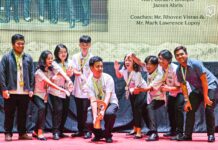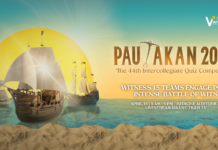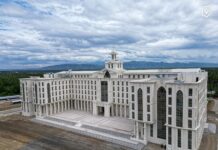PARIS, France–A meeting of two historical and scholastic arsenals.
Invited by no less than the United Nations Educational, Scientific, and Cultural Organization (Unesco), UST showcased its priceless 400-year-long history in a special cultural exhibition at the Unesco headquarters in the French capital.
With the theme “University of Santo Tomas: Four Centuries of Promoting Understanding, Peace, and Culture,” the exhibition, one of the highlights of the University’s year-long Quadricentennial celebration, was mounted at the esteemed Salle de Pas Perdus in the Unesco Headquarters from September 21 to 23.
“The exhibit highlights the University’s achievements within the last four centuries, its key contributions to the Philippine society and culture, and its linkages and ties with the regional and international community,” Philippine Amabassador to France Cristina Ortega said during the opening ceremonies.
She added that Unesco ‘s approval to put up an exhibit in its main house is a form of recognition and affirmation of UST’s contributions to “building knowledge-based societies in a globalized world.”
“Since 1611, UST has been giving quality education to Filipinos. Education that is not purely academic, but is also infused with morality,” Ortega said. “In UST, while you are taught Theology, you are being instilled with moral values. I think, this is what makes UST different from all other universities, especially Catholic universities, in the Philippines.”
Attending the inauguration of the three-day exhibit in behalf of Unesco ‘s Director-General Irina Bokova, is Deputy Director-General Getachew Engida.
According to him, the University’s four-century-old vision and idea on education is similar to the humanism Unesco has been promoting since its establishment.
“Education is the best path for individual realization and a force for social and economic development that can lay the ground for lasting peace,” Engida said. “[Like UST] Unesco pursues the idea that the foundation of peace lie with every individual’s ability to imagine a better world and to shape reality to this direction.”
He added that Bokova, who is at the New York City for a week of general assembly, wished to be at the event.
The exhibit—with sections consisting of “Witness to History,” “Citizen to the World,” “Vanguard of Culture,” and “Custodian of Heritage—offered a glimpse of UST’s rich history through texts, photographs, and other visuals.
The first section, entitled “Witness to the World,” provided a brief description of UST from its establishment during the Spanish period in the 17th century up to the modern era as highlighted by the start of the Quadricentennial year last January, through old documents and images.
Noted in this section was the University’s status of being the veritable Department of Secondary and Higher Education during the Spanish colonized era.
Since then, UST has become an active collaborator in various international fairs, expositions, and exhibitions, and venue to visits of notable persons and other historic encounters in the late 19th and 20th centuries as shown in the second section “Citizen of the World.”
The exhibit was only the latest in a long account of international exchange that included participation in the world fairs held in Vienna (1873), Paris (1878 and 1889), Hanoi (1902 and 1903), and USA (1904 and 1915), among others.
In the third section, called “Vanguard of Culture,” the University’s contributions in religion, government, education and communication, science and health, literature and the press, and art were displayed.
UST established the country’s first medical school that offered new directions in healing. It also houses one of the longest-running publishing houses in the world that has operated for over 300 years now.
It is also home to religious officials who became representatives of the Holy See and statesmen who helped draft the Malolos Constitution, the first democratic document of such in Asia.
The last part of the exhibit, “Custodian of Heritage,” displayed the UST Library’s most prized treasures, including an incunabulum or a book printed before 1500, “Biblia Sacra,” a Plantin Polyglot Bible whose texts are in Hebrew, Latin, Greek, and Armaic whose cost was equivalent to a mansion on the time of its publication, and pre-Hispanic gold treasures. All of them have been carefully preserved by the University throughout the centuries.
“Here in Paris, the University has presented to Europeans the culture of indigenous Filipinos, how it was preserved and developed through the introduction of western culture and indigenized to the Filipino Asian tradition,” Fr. Rolando de la Rosa, O.P., Rector of UST, said. “May this exhibit help you realize that despite the differences in culture, education, and ideology, we are all one as signified by a university like the UST.”
The exhibit also showcased the University’s valuable architectural landscape with its four well-preserved iconic landmarks declared Philippine National Cultural Treasures, and the entire campus proclaimed National Historical Landmark.
“As we bring to you this Quadricentennial exhibit of our very own University, I hope that your knowledge of learning institutions in the Philippines will be enriched, as well as your understanding our country, people, and culture will be deepened,” Ortega said.
UST is the oldest university in Asia and the only Pontifical university, and the largest Catholic university in the world in terms of student population within one campus.
Goodwill emissaries
Following the opening of the exhibit is a concert by two-time “Choir of the World” UST Singers at Salle I still in the Unesco House.
Ortega expressed her appreciation to Unesco “for according the UST Singers the distinct opportunity to perform on the very same stage, where many of the world’s phenomenal artistic and musical talents have performed.”
“Consistent with the exhibit theme, the UST Singers has been the University’s goodwill emissaries–promoting understanding, peace, and culture at both national and international milieus through their outstanding gift of music,” she said.
Under the baton of Fidel Calalang Jr., the UST Singers presented the sacred songs “The Lord’s Prayer” by Albert Hay Malotte, “Alleluia” by Ralph Manuel, “Jubilate Deo” by Calalang, and “O Magnum Mysterium” by Nicholas White.
They also rendered works from classical and contemporary repertoire like Richard Egues’ “El Bodeguero” and Charles Aznavour’s “Une Vie D’Amour,” and shared some folk songs from the Philippines that include “Gabaq-an” by Ruben Federizon, “Sa Libis ng Nayon Medley” by Lucio San Pedro, and “Tuwing Umuulan at Kapiling Ka” by Ryan Cayabyab.
With the ensemble’s distinctive and exceptional musical character and high standard performances, the concert garnered three standing ovations from an audience of over 1, 000.
“I hope that through this, people here in Europe will be able to know Filipinos better as a people,” Ortega said.
The UST Singers is composed of students and alumni of the various colleges and faculties of the University. Since 1992, the group has earned more than 65 top prizes from different competitions around the globe.
Today, the UST Singers is one of the Philippines’ Cultural Amabassadors of Goodwill to the world, its audience being popes, kings, queens, presidents, and other luminaries.
“I am thankful that UST has been brought to France. The Philippines and Filipinos are becoming known in France because of UST,” Ortega said.
The exhibit was organized by a committee that included UST Archivist Regalado Trota Jose as curator, College of Fine Arts and Design Dean Cynthia Loza, College of Architecture Dean John Joseph Fernandez, Office for Public Affairs Director Giovanna Fontanilla, Asst. Prof. Rodolfo Olaso, and layout and graphic designer Jonathan Gamalinda, former Varsitarian assistant art director.















